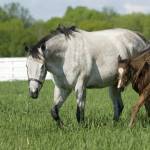Environmental Contaminants May Affect Foals, Mares

In a matter of mere minutes, a foal rushes forth from the protection of its dam’s uterus to a world full of microscopic organisms capable of wreaking mayhem on future health. Foals are born without a “primed” immune system and encounter their first microbes—bacteria, fungi, yeast, viruses, and others—on the journey through the birth canal. Even after consuming their fill of immune-building colostrum, a slew of environmental contaminants are in their vicinity, potentially putting them at risk for serious diseases.
- Botulism. Foals develop botulism by ingesting spores of the bacterium Clostridium botulinum while exploring their new environment. Picked up from soil, these spores persist in the foal’s gastrointestinal tract and produce toxins. Classic signs of botulism in foals, which develop as early as 1 week to about 6 months of age, include progressive weakness and shaking (hence the name of the disease, “shaker foal syndrome”); tongue paralysis and milk leaking from the nose; colic; respiratory distress; and death. Treatment may be successful if the condition is recognized and treated early.
- Leptospirosis. Raccoons, skunks, and other wildlife infected with the bacterium Leptospira interrogansurinate in pasture and natural water sources, “seeding” a foal’s field with the bacterium. The ingested L. interrogans multiplies in the kidney, subsequently spreading to other parts of the body such as the eye. Later in life, the infection can cause leptospiral-associated recurrent uveitis, the most common cause of blindness in horses.
- Rhodococcus equi. Just like Clostridium botulinum, R. equi also forms spores that persist in the soil for prolonged periods of time. This means that inquisitive foals licking and sniffing beside their grazing mothers can inhale the bacterial spores, setting themselves up for pneumonia and abscesses in their lungs.
“Even though milk is a foal’s primary source of nutrients for the first 7-8 weeks of life, foals begin to consume small quantities of water, forage, and their dam’s concentrate within a few days of being born,” explained Kathleen Crandell, Ph.D., a Kentucky Equine Research nutritionist. “Something as innocuous as well-managed pasture can cause foal problems.”
The presence of blister beetles in alfalfa, exposure to other microorganisms in the environment like Escherichia coli and Salmonella, and even toxic plants in their pasture can all pose serious threats to foals.
Keep in mind, too, that noxious feedstuffs mares are exposed to prior to foaling, like endophyte-infected tall fescue, can also be life threatening for the foal.
Proper hygiene goes a long way in protecting foals from environmental contaminants. As always, a veterinarian should be called in as soon as a foal seems out of sorts, as foals should generally be happy, inquisitive, and hungry. Occasional wellness exams will help ease any apprehension about a foal’s health as well, and these may coincide with foal vaccinations and mare checkups.








